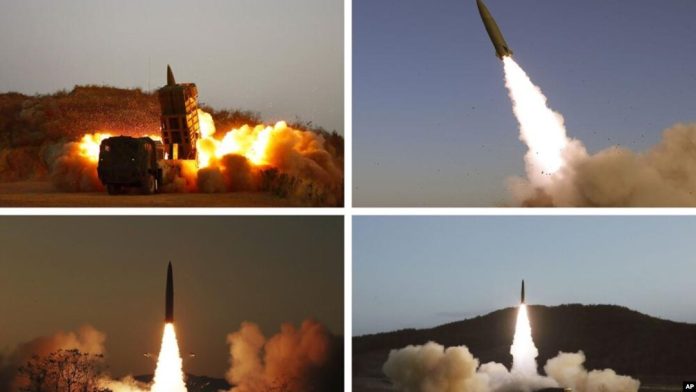In Seoul, South Korea, the latest ballistic missile test by North Korea on Wednesday is reported to have likely failed, according to statements from South Korea’s military. This test occurred amidst heightened tensions following North Korea’s objections to the deployment of a U.S. aircraft carrier for joint military exercises involving South Korea and Japan.
The Joint Chiefs of Staff of South Korea released a statement confirming that North Korea launched a ballistic missile from its capital region at approximately 5:30 a.m. local time on Wednesday (4:30 p.m. Tuesday ET). The missile was aimed towards North Korea’s eastern waters, but it is suspected to have encountered failure during launch.
While South Korean and U.S. intelligence agencies are currently analyzing the specifics of the launch, the Joint Chiefs of Staff did not immediately provide details on the reasons for their assessment of the launch’s failure. Earlier on Wednesday, Japan’s Defense Ministry had also reported detecting a suspected ballistic missile launch by North Korea.

Reports from South Korea’s Yonhap news agency indicated that the North Korean missile traveled approximately 155 miles before the suspected failure. Japanese media sources mentioned that the projectile fell outside Japan’s exclusive economic zone.
The reported missile launch coincided with North Korea’s action of releasing large balloons, believed to be carrying trash, across the border into South Korea for the second consecutive day. This action follows a series of similar launches since late May, which North Korea claims are in response to political leaflets flown into North Korea by South Korean activists. In response to these balloon launches, South Korea briefly resumed propaganda broadcasts via loudspeakers along the border on June 9, a tactic not used in years. South Korea’s military confirmed its readiness to activate these loudspeakers again.
The USS Theodore Roosevelt arrived in South Korea on Saturday, with South Korean President Yoon Suk Yeol boarding the carrier on Tuesday, marking the first visit by a sitting South Korean president to a U.S. aircraft carrier since 1994. Addressing American and South Korean troops on board, President Yoon emphasized the strength of their alliance and its capability to confront any adversary. The USS Theodore Roosevelt is scheduled to depart on Wednesday for the “Freedom Edge” drill, a trilateral exercise involving South Korea, the United States, and Japan. This exercise aims to enhance coordinated responses across air, sea, and cyberspace domains. North Korea’s Vice Defense Minister, Kim Kang Il, criticized the deployment of the U.S. aircraft carrier as reckless and dangerous, echoing previous North Korean assertions that such exercises are rehearsals for invasion, often met with missile tests.
South Korean officials underscored that the upcoming joint training with the U.S. and Japan is essential for bolstering the three nations’ defense capabilities against North Korea’s advancing nuclear threats, particularly amidst North Korea’s deepening military cooperation with Russia. During a recent summit in Pyongyang, North Korean leader Kim Jong Un and Russian President Vladimir Putin signed an agreement stipulating mutual aid in case of attack, and pledged to strengthen bilateral cooperation. Observers note this agreement as the most significant bond between the two countries since the Cold War.
According to the United States and its allies, North Korea has been supplying Russia with conventional arms, supporting its military efforts in Ukraine, in exchange for economic and military assistance. North Korea’s reported missile launch on Wednesday marks its first weapons demonstration since May 30, when Kim Jong Un oversaw the firing of multiple rocket launchers capable of carrying nuclear warheads, simulating a preemptive strike on South Korea. This drill followed the failure of North Korea’s attempt to launch its second spy satellite into orbit, with the rocket exploding shortly after liftoff.
Since 2022, North Korea has significantly accelerated its weapons testing program, aiming to bolster its nuclear arsenal in response to what it perceives as an escalating U.S. military threat. International analysts believe North Korea’s ultimate goal is to leverage its expanding nuclear capabilities to negotiate more favorable terms with the United States when diplomatic negotiations resume.


